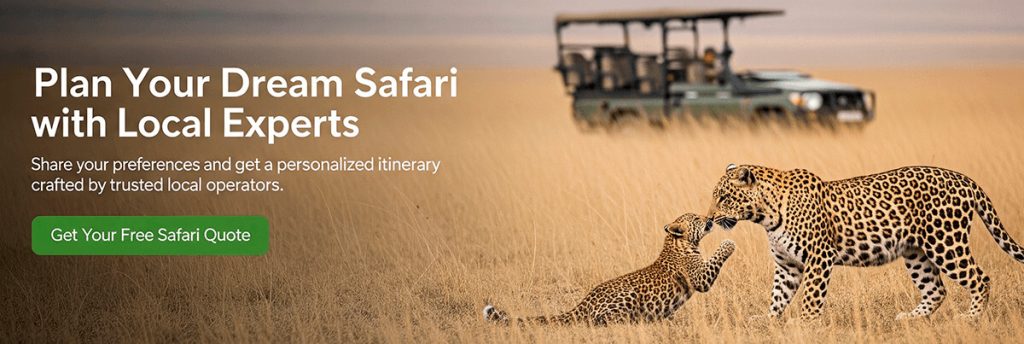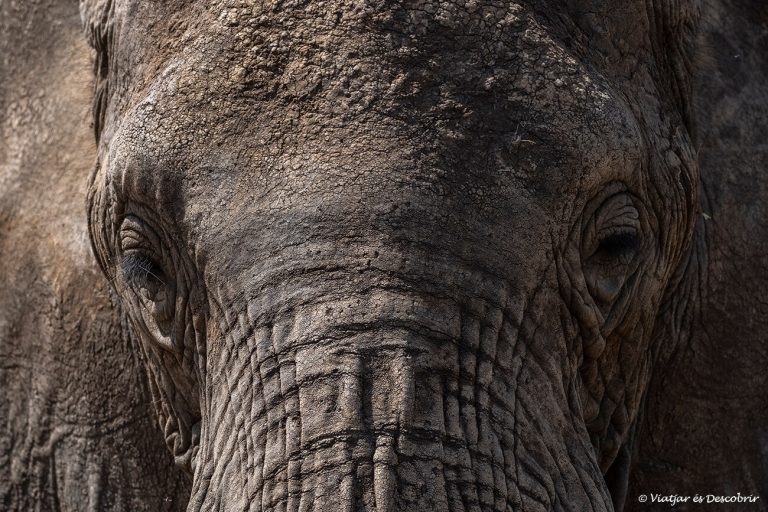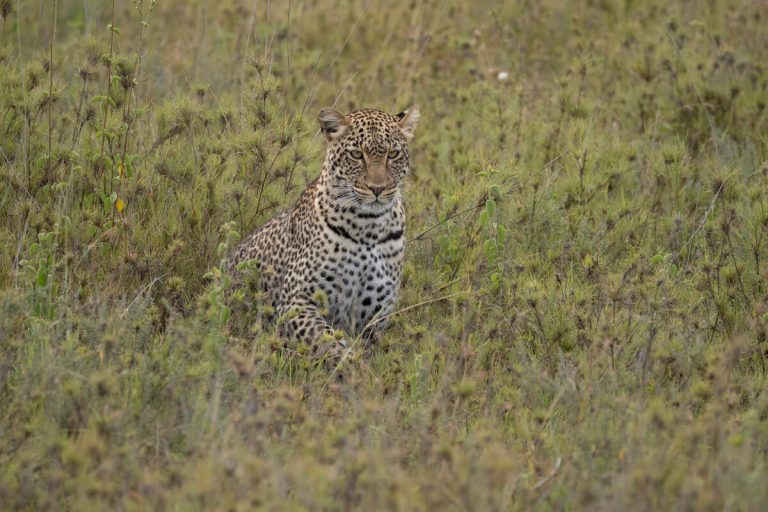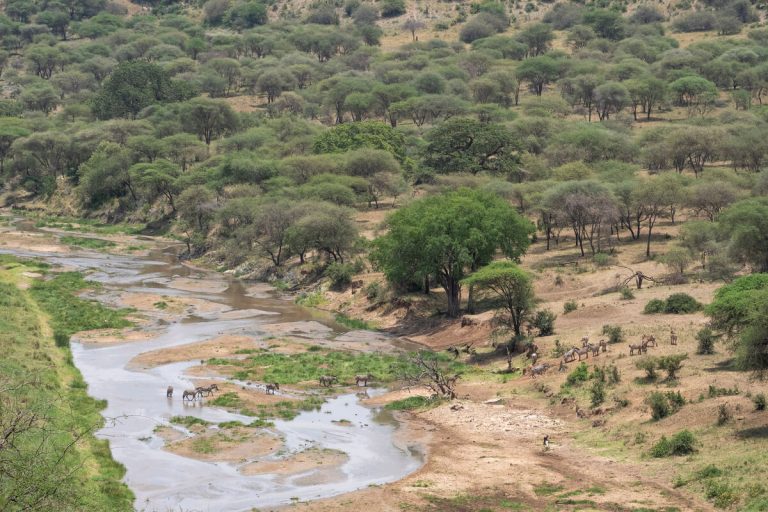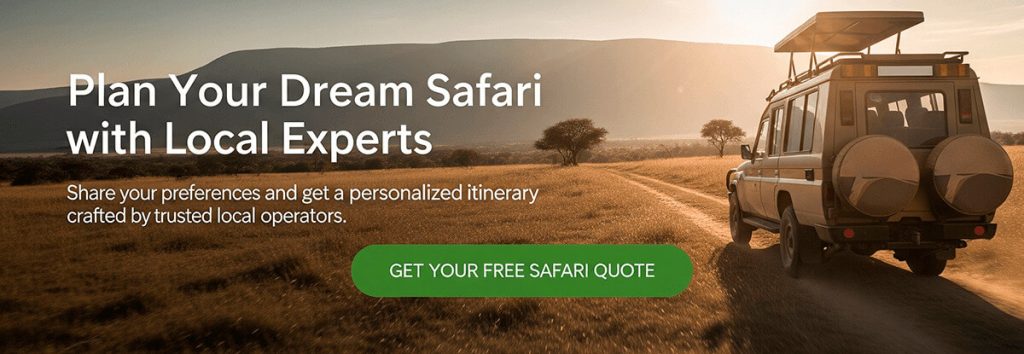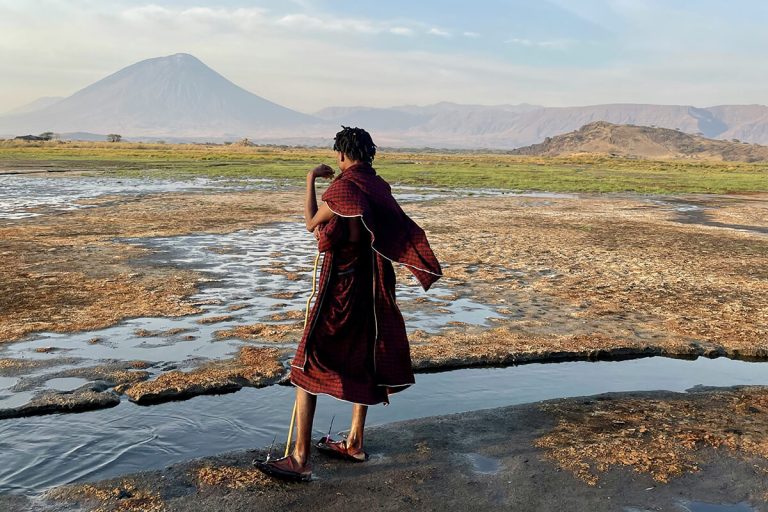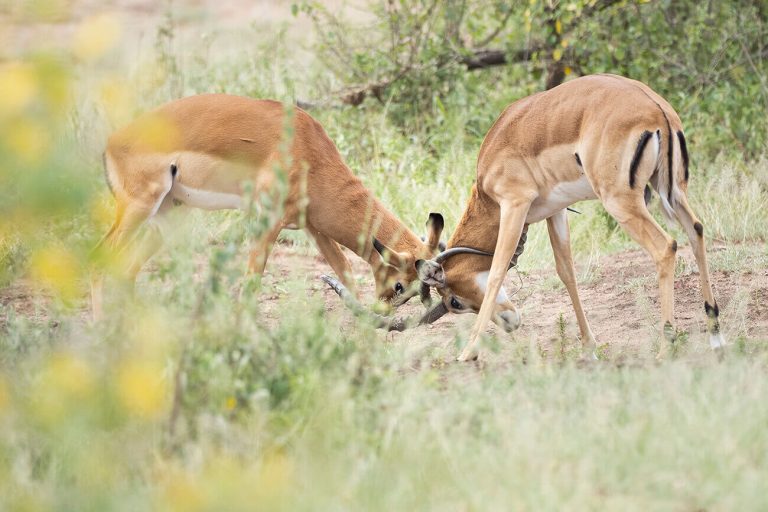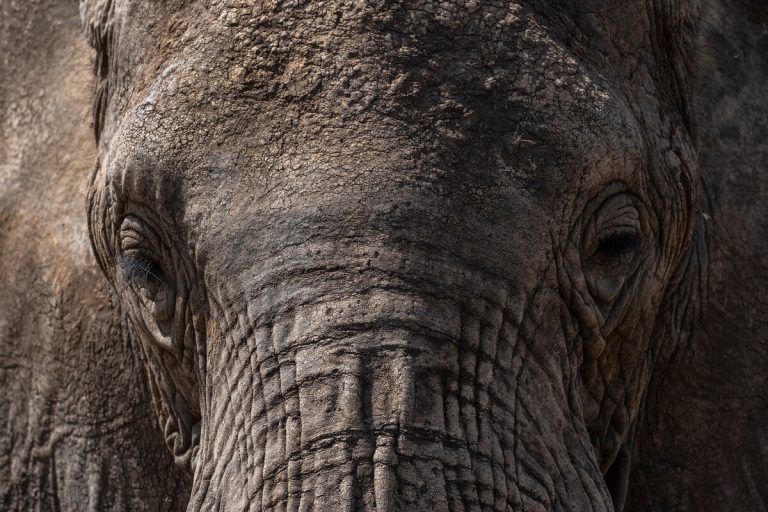Going on a safari in Tanzania with a local operator is a unique and unforgettable experience. There’s nothing like planning […]
Read MorePlanning a Trip to Tanzania: Itinerary, Cost & Tips
Traveling independently to Tanzania in search of its spectacular wildlife allows you to experience the thrill of African safaris. When planning a trip to Tanzania, it’s common to follow a route through the northern national parks, where some of the planet’s most renowned ecosystems are concentrated. The unique landscapes of Tarangire National Park and Lake Manyara National Park usually mark the start of most itineraries. But they are only a prelude to Tanzania’s great icons: the Ngorongoro Crater and Serengeti National Park.
However, safaris are not the only activity to consider when planning a trip to Tanzania. For those seeking adventure and hiking, climbing Africa’s highest peak, Kilimanjaro, is an unforgettable experience. You can also explore less crowded routes, such as the ascent of Mount Meru; shorter hikes from Moshi or Tanga; or the climb to the country’s only active volcano, Ol Doinyo Lengai. After active days, the Zanzibar archipelago offers calm and relaxation on its paradisiacal white sandy beaches.
For me, the main reason for planning a trip to Tanzania was its wildlife. I wanted to dedicate my journey to exploring the northern savannas. That’s why I focused my entire trip on safaris. But during the preparation of my itinerary, I realized that Tanzania is a very complete country, and you can organize diverse routes according to your travel preferences when planning a trip to Tanzania.
Planning a Trip to Tanzania: What to know before the trip
Essential Travel Information
How to Get to Tanzania
If you are planning a trip to Tanzania and want to do a safari through the northern national parks, it’s common to start your journey from Kilimanjaro International Airport. This airport is about an hour from Arusha. There are also some international routes that stop in Dar es Salaam and then fly directly to Arusha Airport, which is around 15 minutes from the city.
If you are planning a trip to Tanzania that includes Zanzibar, you can fly directly to the island’s airport: Abeid Amani Karume International Airport.
For those planning a trip to Tanzania through the southern national parks, a much less touristy area, it’s better to fly into Dar es Salaam’s Julius Nyerere International Airport.
If your plan involves combining Kenya and Tanzania, you can fly from Nairobi to Kilimanjaro International Airport, or take a bus connecting Nairobi with Arusha. The bus ride takes between five and eight hours. One of the best-rated companies is Riverside Shuttle Bus.
Getting Around Tanzania
When planning a trip to Tanzania with safaris in mind, having a 4×4 vehicle is essential. You can arrange your route directly with an agency (local or international), rent a car with a driver-guide, or rent a car and drive yourself. Some companies that rent cars include Road Trip Africa, Arusha Car Rental Safaris, and Gladiola Adventure.
For longer trips around the country, between towns or cities, you can take buses or book private transport from your accommodation. On Bookaway, you can compare prices and book bus or minivan rides across Tanzania.
Where to Stay
Throughout Tanzania’s tourist areas, including national parks, there is a wide variety of accommodation options—from simple lodgings to luxurious lodges with many amenities. Many of these accommodations appear on Booking.com.
Especially when visiting Serengeti National Park and the Ngorongoro Conservation Area, keep in mind that these places are far from any town. Therefore, you will need to stay inside these natural areas. The only affordable option there is camping in municipal campsites, costing around $35 per person. On the other hand, lodges tend to be mid to high quality and usually cost no less than $250 per night (for two people).
Emergency Phone Numbers
The emergency phone number in Tanzania is 112.
Vaccinations
When planning a trip to Tanzania, yellow fever vaccination is not required unless you are arriving from a country where yellow fever is endemic. Tanzanian authorities require the vaccine if you have had a layover longer than 12 hours in a yellow fever endemic country (such as Kenya).
Vaccinations for hepatitis, tetanus, and typhoid are recommended. Depending on the length of your trip, other vaccines might be suggested. It’s best to visit a travel medicine center a few months before your trip for complete health advice.
Malaria
When traveling independently to Tanzania, it’s important to remember that malaria exists in the country (except Zanzibar). To avoid mosquito bites, take all possible precautions: use good insect repellent, mosquito nets, and wear light-colored, long-sleeved clothing. While most accommodations provide mosquito nets, they often have holes, so it’s wise to bring an additional one.
In most cases, malaria prophylaxis medication is advised. Again, consult a tropical medicine or travel health specialist.
SIM Card
The best network coverage in Tanzania comes from Airtel and Vodacom. At Kilimanjaro International Airport, you can buy a Vodacom SIM card. The cost is about $7 for 5 GB valid for 7 days. SIM cards are also available in most cities.
Plug Type
In Tanzania, plugs are type G. You will need to bring an adapter.
Visa, Language & Climate
Language
The official languages of Tanzania are English and Swahili.
Some common words you will surely hear when planning a trip to Tanzania independently are:
- Jambo (hello)
- Karibu (welcome, but also used as “you’re welcome”)
- Asante (thank you)
- Asante sana (thank you very much)
Capital
Dar es Salaam
Visa
Spanish citizens need a visa to enter Tanzania. It can be processed upon arrival or online through this website: https://eservices.immigration.go.tz/visa/. Visa approval can take more than a week, so it’s recommended to handle this well in advance when planning a trip to Tanzania. The cost is $50.
Time Zone
Tanzania’s time zone is GMT+3.
Climate
When planning a trip to Tanzania, it’s important to pack for its tropical climate. Temperatures remain quite stable throughout the year. What changes between months is the rainfall. Mainly, there is a long rainy season (known as masika) that starts in March and ends in early June. The short rainy season (known as vuli) lasts from November to early January. During the rest of the year, rain is generally scarce.
The average temperature is around 25°C (77°F). However, nights can be cool, so it’s advisable to bring some warm clothing. Also, some areas within the Ngorongoro Conservation Area are over 2,000 meters above sea level, which causes temperatures to drop significantly at night.
Economy
Currency
The official currency of Tanzania is the Tanzanian Shilling (TZS). Currently, 1 euro is approximately 2,500 TZS. To do quick mental conversions, it’s good to remember that 10,000 TZS equals about 4 euros.
However, the safari industry (payments to local agencies, park entry permits…) usually quotes prices in US dollars. In many cases, payments are also required in dollars, though local currency is generally accepted.
Card payments are becoming more common for paying local agencies, some hotels, and large supermarkets. Still, a surcharge of 3% to 4% usually applies.
National park entry permits are paid by card at the park gates, as cash is not accepted. However, permits for entering the Ngorongoro Conservation Area and descending into the Ngorongoro Crater cannot be purchased at the entrance. These must be arranged in advance—you can read how to do this here.
It’s important to understand how park permits work if you are planning a trip to Tanzania independently. If you travel with an agency, permit costs are included and the guide handles all arrangements.
Prices
Basic goods in Tanzania are cheaper than in Europe, North America or Oceania.
That said, entry permits for national parks and reserves are quite expensive for foreigners. Prices vary by park but usually range between $60 and $90.
Here are some examples of costs you might encounter when planning a trip to Tanzania:
- Combo meal in a local restaurant: 7,000 TZS
- Starter and main course at a standard hotel restaurant: 15,000 TZS
- 1.5-liter bottle of water: 2,000 TZS
- 1 liter of gasoline: 2,900 TZS
- Permit to camp in municipal campgrounds inside national parks: $35 per person
- Accommodation in a lodge on the outskirts of a national park: $35 per double room (the cheapest option)
- Accommodation in a tent with a bed inside a national park: $250 per double room (the most affordable option)
- Entry permit to Serengeti, Kilimanjaro, and Nyerere National Parks: $82.60 (valid for 24 hours.
- Entry permit to Tarangire, Lake Manyara, and Arusha National Parks: $59 (valid for 24 hours)
If traveling with a local operator, prices vary depending on chosen accommodations and whether you travel in a group or privately. The cheapest options (group tours with camping) cost about $200 per person per day.
Tips
Tipping during a trip to Tanzania is not mandatory but is expected, especially for tourism services and when the customer is satisfied.
It’s better to tip using local currency.
Suggested tip amounts are:
- Safari guide-driver: Around $10 per day (if traveling in a group, this can be reduced to about $8)
- Cook: Budget safaris often include a cook. It’s customary to tip about $4 per day (reduced slightly if traveling in a group)
- Hotel staff: Between $2 and $10 per day per person (usually there’s a communal tip box for all staff)
Bargaining
When planning a trip to Tanzania, bargaining should only be done when shopping in local markets or souvenir shops. Generally, initial prices tend to be triple what you should pay.
Safety Tips When Planning a Trip to Tanzania
Tanzania is generally a safe country, especially in and around the national parks, where crime is very rare. However, extra caution is recommended in larger cities like Arusha and Dar es Salaam.
If you’re planning a trip to Tanzania independently, it’s a good idea to check your country’s foreign travel advice before departure. Some areas near the borders with Burundi and Mozambique are considered high-risk and should be avoided.
Here are some essential safety tips to keep in mind:
- Avoid isolated areas, especially at night.
- Do not walk alone in cities after dark. Use official taxis or ones arranged by your accommodation.
- Avoid displaying valuables or large amounts of cash.
- If booking a safari with a local agency, always check their reviews on Tripadvisor before making any payments.
- Avoid driving at night. Although the roads are generally in good condition, there is little lighting, which increases the risk of accidents.
- If staying inside a national park, remember that most accommodations are unfenced, and wildlife can roam freely. Always follow the instructions given by your guide or the lodge staff. At night, never leave your tent or room.
All About Safaris in Tanzania
How to Book Your Kenya Safari
The easiest and most recommended way to book your Tanzania safari is through a local tour operator. For my own trip, I chose a Tanzanian company and couldn’t have been more satisfied. Local operators handle all the logistics—accommodation, national park permits, meals, and transportation—and they’re often up-to-date on wildlife movements, which greatly enhances your chances of unforgettable sightings.
You can request personalized quotes from trusted local tour operators through Safaris by Locals.
While booking through a local operator is the most popular and reliable option, it’s not the only one. You can also explore self-drive safaris, fly-in safaris, or international tour packages that include flights, accommodation, and safari activities. Each option comes with its own pros and cons depending on your travel style and budget.
1. Self-Drive Safari
Self-driving in Tanzania is possible and might appeal to adventurous or budget-conscious travelers. However, the savings are usually minimal once you factor in park fees, 4×4 rental, fuel, accommodation, and navigation tools. More importantly, without a professional guide, it’s easy to miss key wildlife sightings—especially in vast areas like the Serengeti or remote parks like Nyerere National Park.
For most travelers, especially first-timers, we don’t recommend self-driving. A guided safari is far more rewarding and stress-free.
2. Private Safari with a Local Tour Operator
Booking a private safari with a local Tanzanian operator is often the best combination of value, flexibility, and comfort. Your guide will not only drive but also spot animals, interpret behavior, and take care of all the logistics.
Reputable local operators usually have strong partnerships with lodges and camps, giving them access to better rates and availability—especially during high season. Prices can vary depending on the quality of the guide, vehicle, and accommodation. Budget options might cut corners, so always check reviews and ask detailed questions before booking.
You can easily request competitive quotes from vetted local agencies on Safaris by Locals.
3. Lodge-Based Safari Packages
Some lodges in Tanzania offer all-inclusive safari packages that include accommodation, meals, and game drives. These can be convenient if you plan to stay in one location for several days. However, they tend to be more expensive and often include shared game drives, meaning less control over your schedule and how long you spend at each wildlife sighting.
If your priority is maximizing animal encounters and enjoying a fully personalized experience, a private safari with a local operator is usually the better option.
How Much Does a Tanzania Safari Cost?
A typical private Tanzania safari costs around $300 per person per day. This price covers accommodations, park fees, meals, and all activities. For shared group safaris, you can expect to pay around $150 per person per day, but these tend to have more basic accommodations.
Here’s a breakdown of typical safari costs based on comfort level:
- Shared Budget: From $140 per day
- Private Budget: From $300 per day
- Private Midrange: From $400 per day
- Private Luxury: From $650 per day
- Private Luxury +: From $1,000 per day
These prices are for booking through a local tour operator. Booking through an overseas company will significantly increase the cost due to travel agent fees.
Several factors affect the cost, including the size of your group, the type of vehicle (minivan vs. Land Cruiser), and the time of year you visit. The high season (July-December) sees an increase in park fees, so visiting from January to June can save you money.
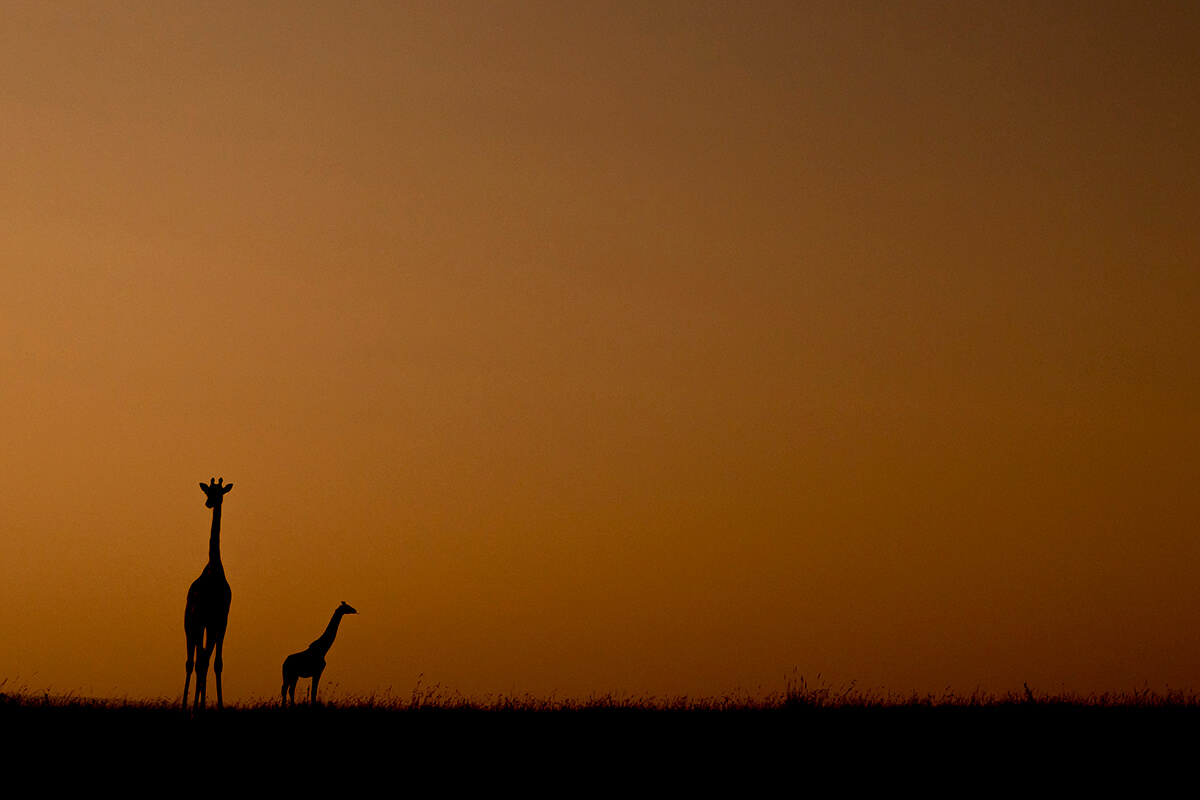
How Long to Spend in a Tanzania Safari
The ideal duration for a Tanzania safari depends on your interests and the parks you want to visit. Most travelers spend 7 to 10 days on safari, which allows enough time to explore iconic destinations like the Serengeti, Ngorongoro Crater, and Tarangire National Park.
If you’re short on time, a shorter itinerary focusing on the Northern Safari Circuit—such as Serengeti and Ngorongoro—can still offer an unforgettable experience.
For a deeper and more varied adventure, consider a longer safari that includes lesser-visited parks like Lake Natron, Ruaha, or Nyerere National Park. Keep in mind that travel times between parks can be significant, so it’s important to plan your route carefully to make the most of each day in the wild.
Best Time to Plan a Trip to Tanzania

Best Time
From June to October
The best time to travel to Tanzania varies slightly depending on the area you want to visit.
The national parks in northern Tanzania can be visited year-round. However, the months from June to October are especially ideal due to the low rainfall. Additionally, from June to July, you can witness the Great Wildebeest Migration in the Serengeti. On the other hand, from late January to March is the best time to see the calving (the birth of a large number of wildebeest) in the Lake Ndutu area.
The national parks in southern Tanzania are best visited from June to October. During the rainy seasons, some areas become inaccessible and some lodges close.
If you plan to climb Mount Kilimanjaro, the best months to do so are January and February.
High Season
From June to December
The most touristy part of Tanzania is its northern national parks, especially the Serengeti and the Ngorongoro Crater. The high season in these parks runs from June to December, with the peak of visitors occurring between July and September. During these months, prices increase significantly, and it is advisable to book safaris in advance.
In the southern national parks, although there are also more tourists from June to September, it is a region that never feels crowded.
Low Season
From January to May
The first five months of the year are usually low season in Tanzania. The low season is especially noticeable during the rainy months (March, April, and May). During this period, you can still enjoy the northern national parks, although the rain may affect some days. There are usually fewer vehicles in the parks.
Best Weather
From June to September, January and February
From June to October, it hardly rains in Tanzania. These are the dry season months, making it a great time to go on safari in all the national parks across the country.
Between January and February, there is usually little rain as well. However, occasional showers may occur.
Rainy Season
March, April and May
The main rainy season in Tanzania takes place between March and May. These months are marked by long periods of rain, high humidity, and mostly cloudy skies. This results in a noticeable increase in vegetation.
When the rains are heavy, some of the roads in the national parks become impassable, especially in the southern part of the country.
The Best Tanzania Destinations
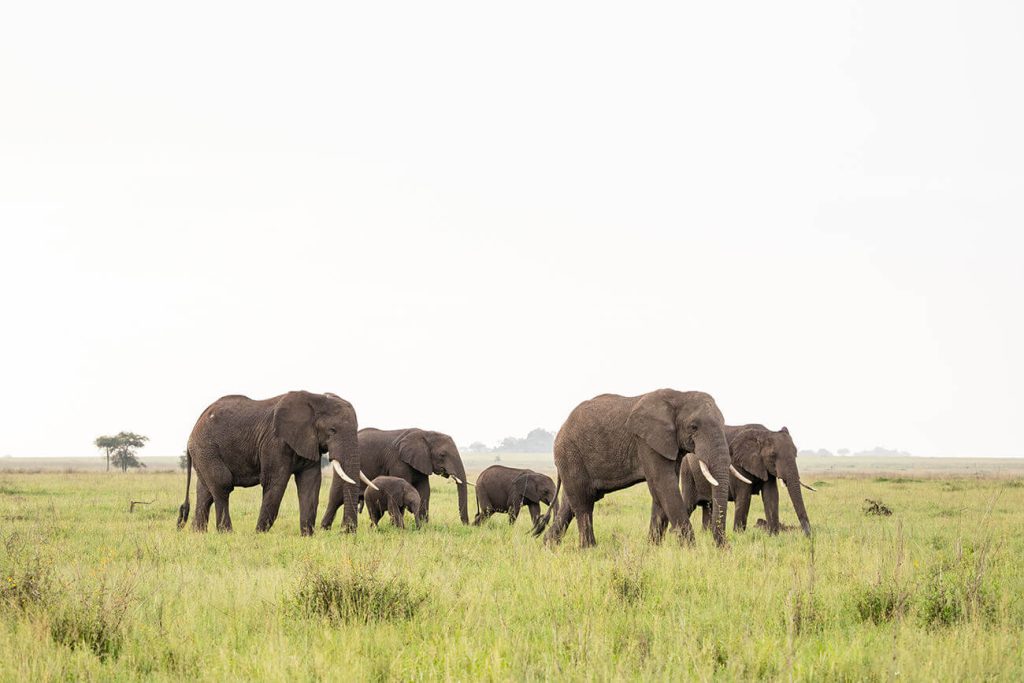
Serengeti National Park
Serengeti National Park is a famous wildlife area in Tanzania, known for its vast plains and rich biodiversity. It hosts the Big Five—lions, elephants, giraffes, zebras, and cheetahs. Between June-July and October-November, you can see the amazing Great Wildebeest Migration, one of nature’s greatest spectacles.
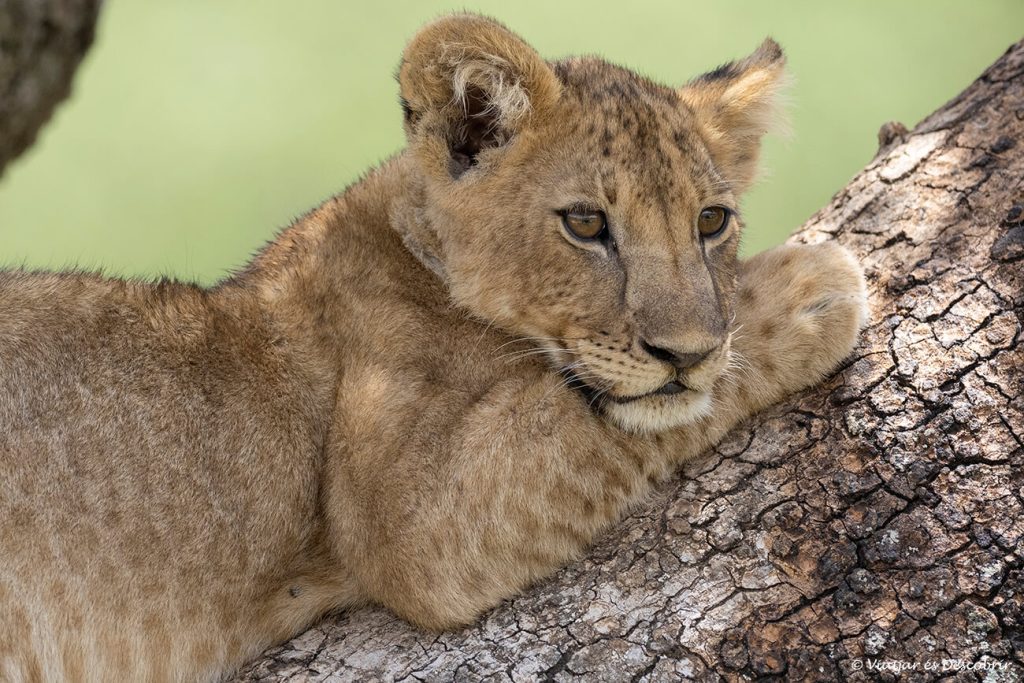
Tarangire National Park
Tarangire National Park is a unique safari destination in Tanzania known for its vast baobab trees and large elephant herds. Its dry season draws wildlife to the Tarangire River, making animal sightings easier and more frequent. It’s also a great place to spot predators like lions and elusive leopards.

Ngorongoro Conservation Area
Ngorongoro Conservation Area in Tanzania is famous for the vast Ngorongoro Crater, one of the largest intact volcanic calderas. Its diverse habitats support abundant wildlife, including the Big Five. Nearby Ndutu is known for the wildebeest calving season, offering amazing wildlife viewing.
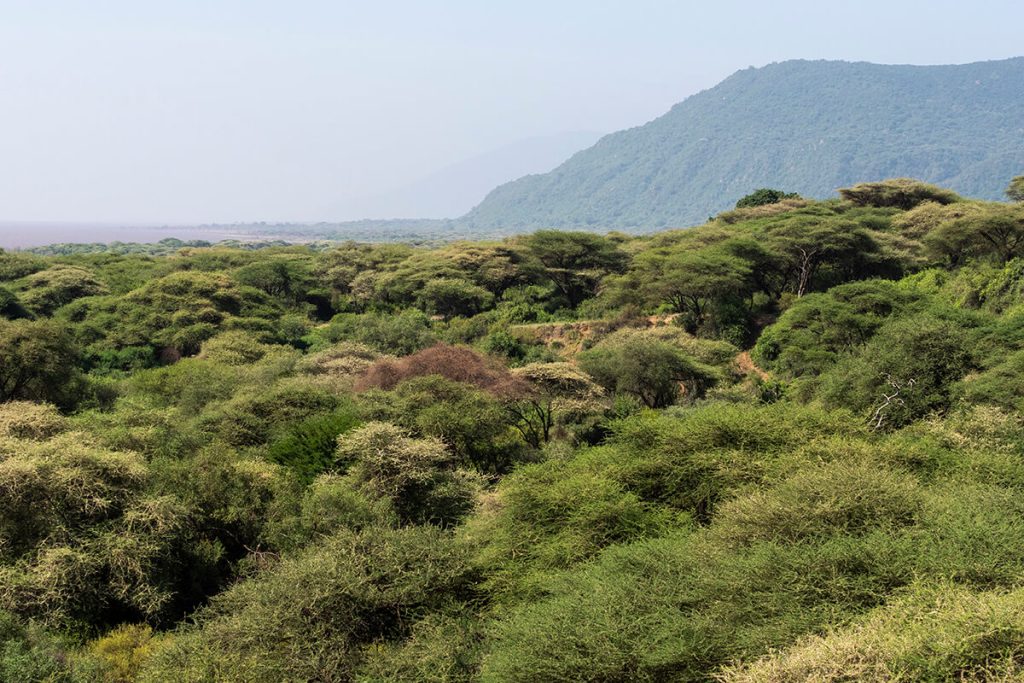
Lake Manyara National Park
Lake Manyara National Park in Tanzania is known for its beautiful lake, lush forests, and large flocks of flamingos. It’s famous for tree-climbing lions and offers great chances to see elephants, baboons, giraffes, and many bird species.
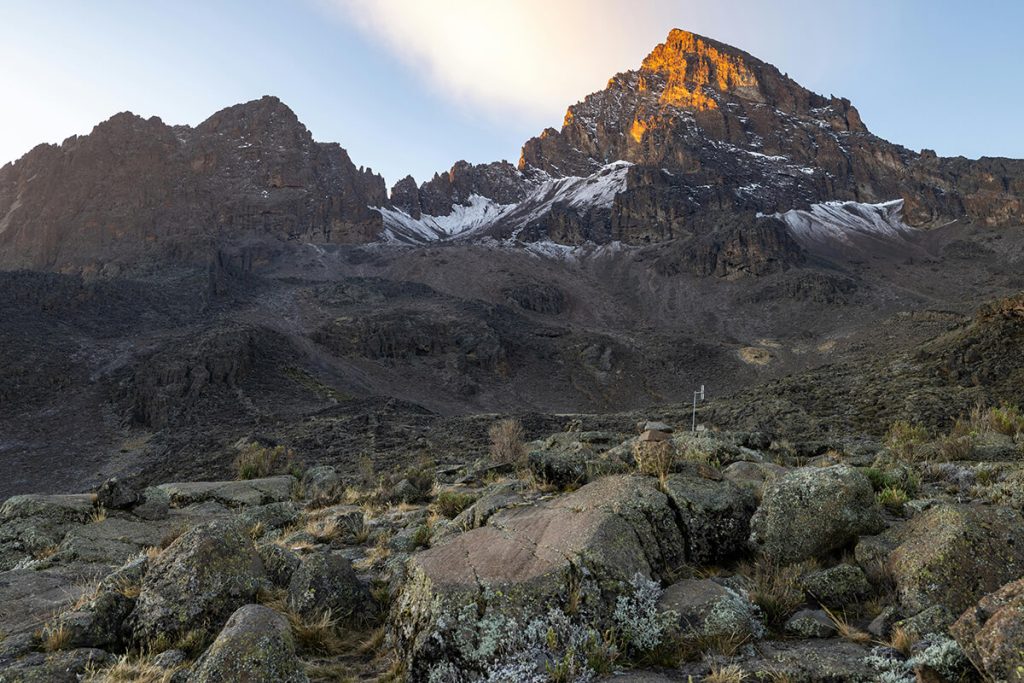
Kilimanjaro National Park
Kilimanjaro, Africa’s highest peak at 5,895 meters, is a famous volcanic mountain that doesn’t require advanced climbing skills. Due to the altitude, fitness and precautions are important. Hiring a guide, cook, and porters is mandatory, making the climb costly, and independent climbing isn’t allowed.
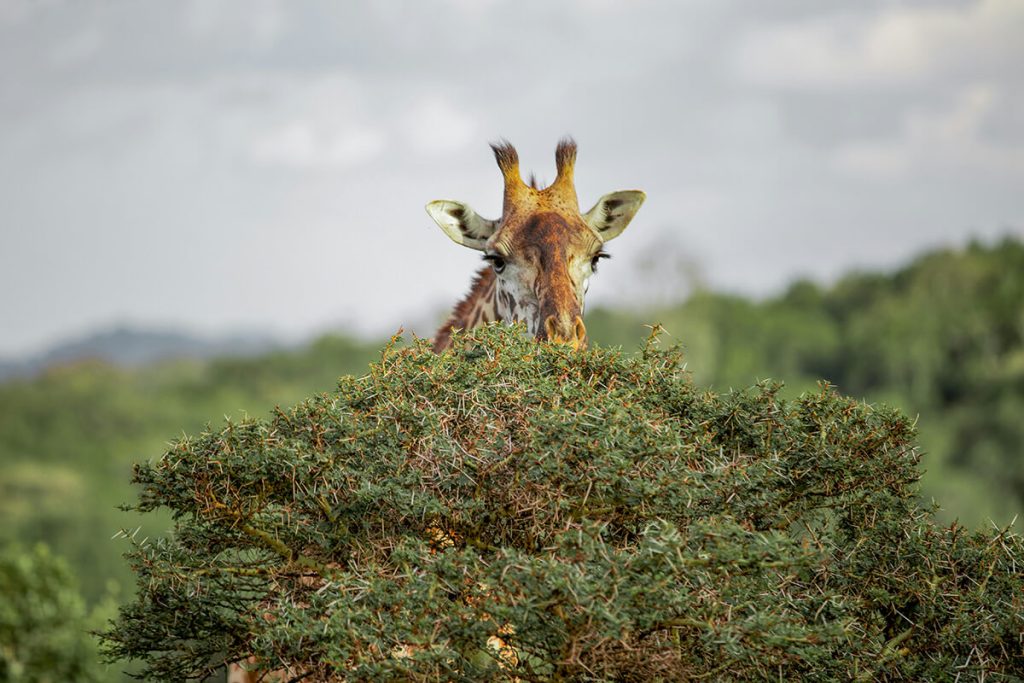
Arusha National Park
For a safari near Arusha city, Arusha National Park is ideal. Though small and predator-free, it offers sightings of giraffes, zebras, buffaloes, elephants, and monkeys. Visitors can enjoy game drives, walking safaris, and boat trips.
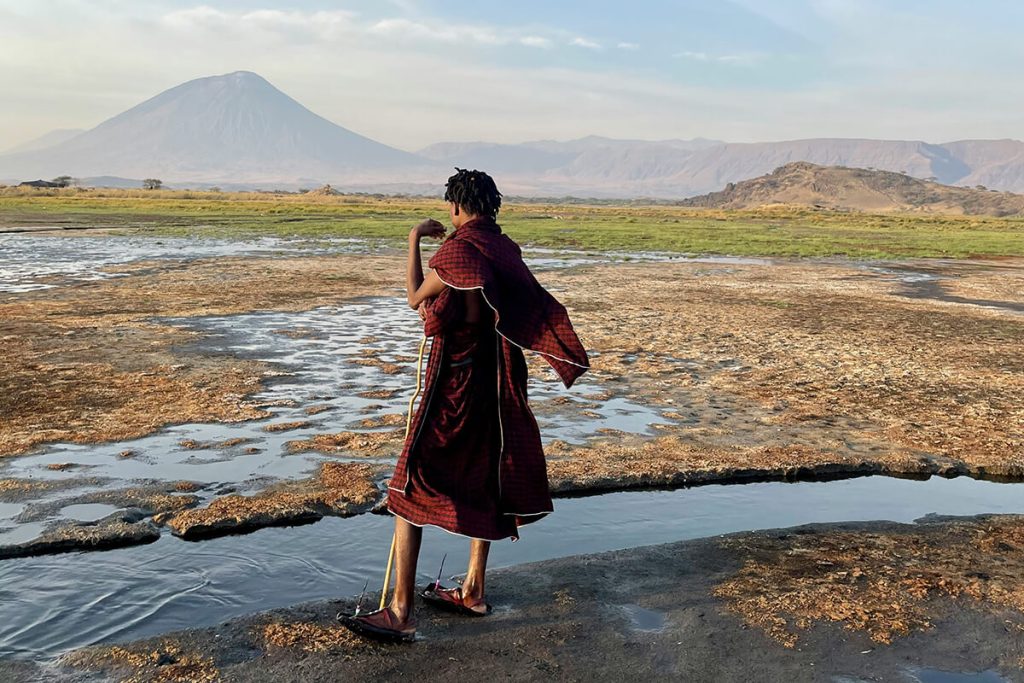
Lake Natron and Ol Doinyo Lengai
Lake Natron in northern Tanzania is a highly alkaline saline lake that supports many birds, especially flamingos. Nearby is Ol Doinyo Lengai, the active “Mountain of God” volcano, famous for its rare black lava eruptions and popular with nature lovers.
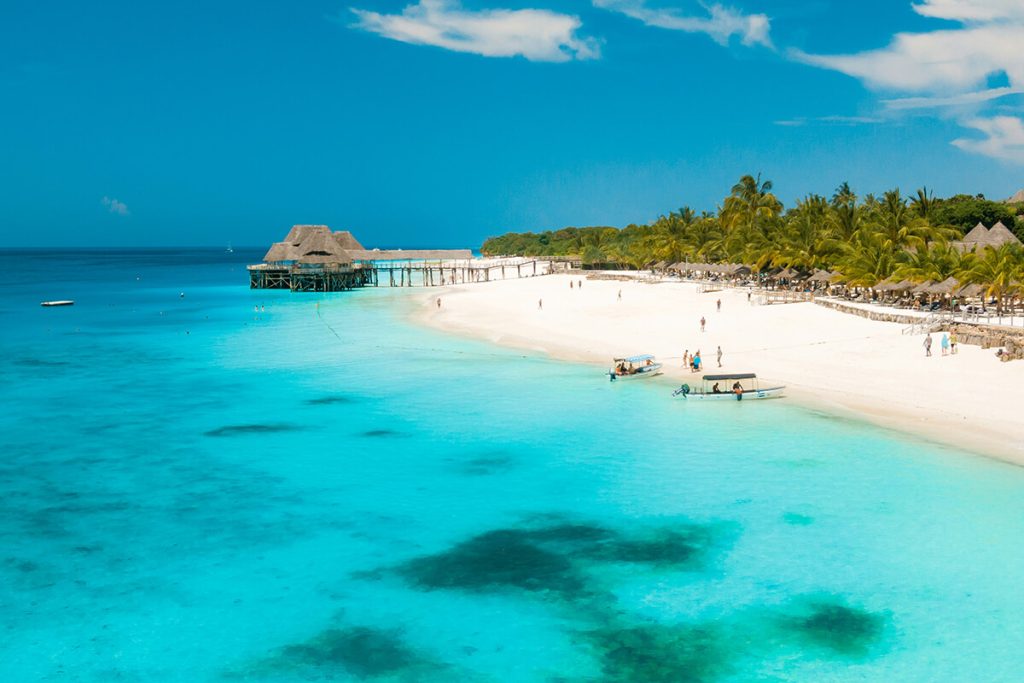
Zanzibar
Visiting Tanzania and spending days in Zanzibar can be a trip highlight. Its white sandy beaches and clear Indian Ocean waters are perfect for relaxing. Zanzibar also offers rich culture and history, especially in Stone Town—a UNESCO World Heritage Site known for its narrow streets, markets, and mosques.
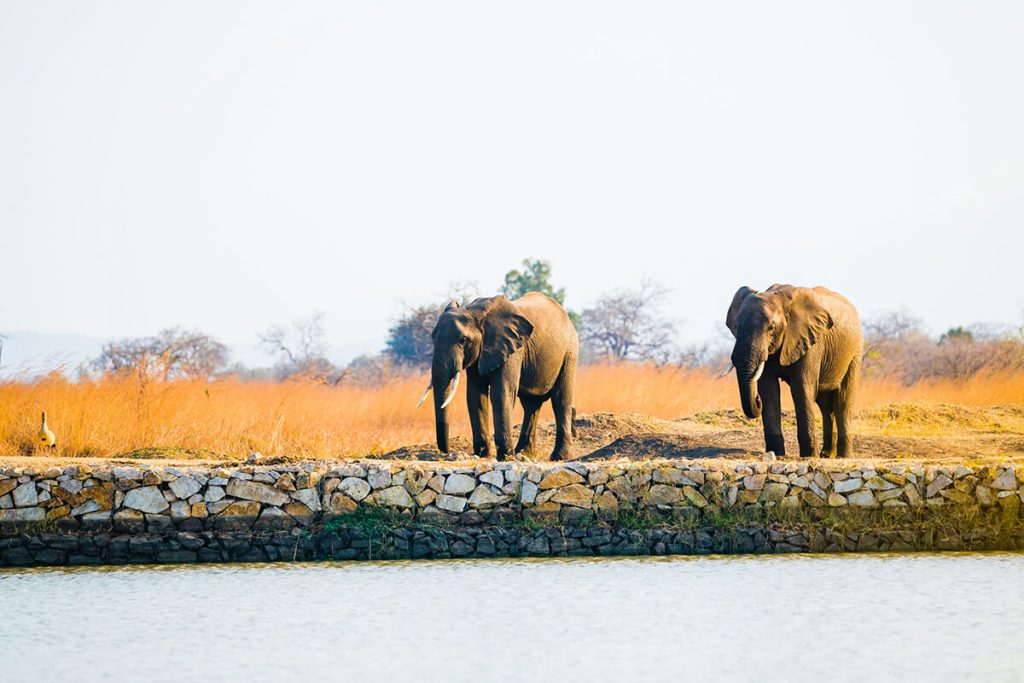
Southern Tanzania National Parks
Southern Tanzania’s national parks are a hidden gem for wildlife lovers. Nyerere National Park, the largest in Tanzania, is great for seeing herbivores and large lion prides. Mikumi offers elephants, buffaloes, hippos, and occasional lions. Ruaha is ideal for spotting predators like lions and rare African wild dogs. Nearby, Udzungwa Mountains National Park is perfect for hiking and seeing the unique Udzungwa red colobus monkey.
Tanzania Safari Planning: All My Travel Guides
Serengeti Safari Guide: How to Plan the Perfect Safari in Tanzania
A safari in Tanzania allows you to immerse yourself in the most classic scenes from African savanna documentaries. It’s about […]
Read MoreHow to Make a Safari in Tarangire National Park
Tarangire National Park, located in the northern part of Tanzania, is one of the most visited parks in the country. […]
Read MoreSafari in Kenya or Tanzania: which one is the best
Deciding whether to go on a safari in Kenya or Tanzania is often one of the first questions when planning […]
Read MorePlanning a Trip to Tanzania: My Experience
Although when traveling to Tanzania you can visit very diverse areas with a wide range of activities, my route through the country focused on safaris in the national parks of northern Tanzania. Traveling alone, I realized it would be very expensive to do an independent trip renting a car with a driver-guide: some of the national park entry permits have a very high price per vehicle—for example, to enter the Ngorongoro Crater you have to pay $295 per car.
For this reason, I decided to book group safaris through local agencies. These are budget safaris, costing around $200 per day. You travel with a group of six people and usually sleep in tents at some of the municipal campsites inside the national parks. Besides the guide, a cook also accompanies the group to prepare all meals. Everything is very well organized, and it’s a good way to do a safari more economically.
The drawback of group safaris is that you cannot customize the itinerary, and the longer options tend to be six days. For me, that was too short, so I finally booked a six-day safari and then a four-day one. Obviously, it wasn’t the most practical or optimal route, as I had to travel some quite slow roads twice. But this allowed me to greatly reduce the costs of safaris in Tanzania.
6-day group safari: In search of the Great Migration
Specifically, I first did a six-day safari with the local agency Meru Slopes Tours & Safaris. I paid $1,170, which included the six days of safari plus airport transfers, one hotel night before the safari, and one hotel night after the safari. The itinerary we followed was:
- Day 1: Departure from Arusha and afternoon safari at Tarangire National Park.
- Day 2: Transfer to the Ngorongoro Conservation Area, where we descended to Lake Ndutu looking for the Great Wildebeest Migration. We ended the day with a safari in Serengeti National Park while heading to the campsite in the central area of the park (Seronera area).
- Day 3: Full day safari in Serengeti National Park.
- Day 4: Morning safari in Serengeti National Park and transfer to Simba Campsite (the campsite closest to Ngorongoro Crater).
- Day 5: Safari in Ngorongoro Crater and transfer to Mto wa Mbu.
- Day 6: Safari in Manyara National Park and transfer back to Arusha.
This itinerary is one of the most recommended to get to know some of Tanzania’s most famous national parks. With a bit of luck, you can see the iconic Big 5 (elephant, lion, leopard, buffalo, and rhinoceros) and enjoy the variety of landscapes between the parks.
4-day group safari: Northern Tanzania national parks
With the second group safari I booked, a four-day trip, I visited some of the same areas again. But with wildlife, every safari is different. To try different agencies, I booked this second route with the local agency Colours Africa Tours and Safaris. It cost me $770. The itinerary we followed was:
- Day 1: From Arusha to central Serengeti with an afternoon safari.
- Day 2: Morning safari in Serengeti National Park and transfer to Simba Campsite (the campsite closest to Ngorongoro Crater).
- Day 3: Safari in Ngorongoro Crater and transfer to Mto wa Mbu.
- Day 4: Safari in Tarangire National Park.

Discovering Tanzania’s Northern Parks: My Safari Experience
Tarangire National Park: What I Saw on a Two-Day Safari
Tarangire National Park is the park of baobabs and elephants. The silhouette of the large baobab trees shapes a landscape where it’s not hard to find large groups of elephants, who approach these trees to scratch themselves or sharpen their tusks.
Tarangire is the sixth largest national park in Tanzania, covering an area of 2,850 km². Especially during the dry season, from June to November, it is an exceptional park for safaris. During these months, around 55,000 herbivores gather in the park, searching for the scarce water available in the area.
Besides elephants, it’s very common to see giraffes, zebras, wildebeests, impalas, and buffaloes. Regarding big cats, lions are often spotted on many safaris. With a bit of luck, you might also see a leopard or a cheetah.
How to get to Tarangire National Park
This national park is located about 110 kilometers from Arusha. It takes around two and a half hours to get there by car.
My experience at Tarangire National Park
During my trip to Tanzania, I did two safaris in this national park, and on both I enjoyed very close sightings of several groups of elephants, many with very young calves. On the first safari, I also saw a cheetah, although quite far away, and a pair of adult lionesses.
The best moment came at the end of the second safari in this park. I spotted a group of lionesses and cubs about three months old sleeping in the branches of a tree. It was a long and very close observation, perfect to fully enjoy the kings of the savanna.
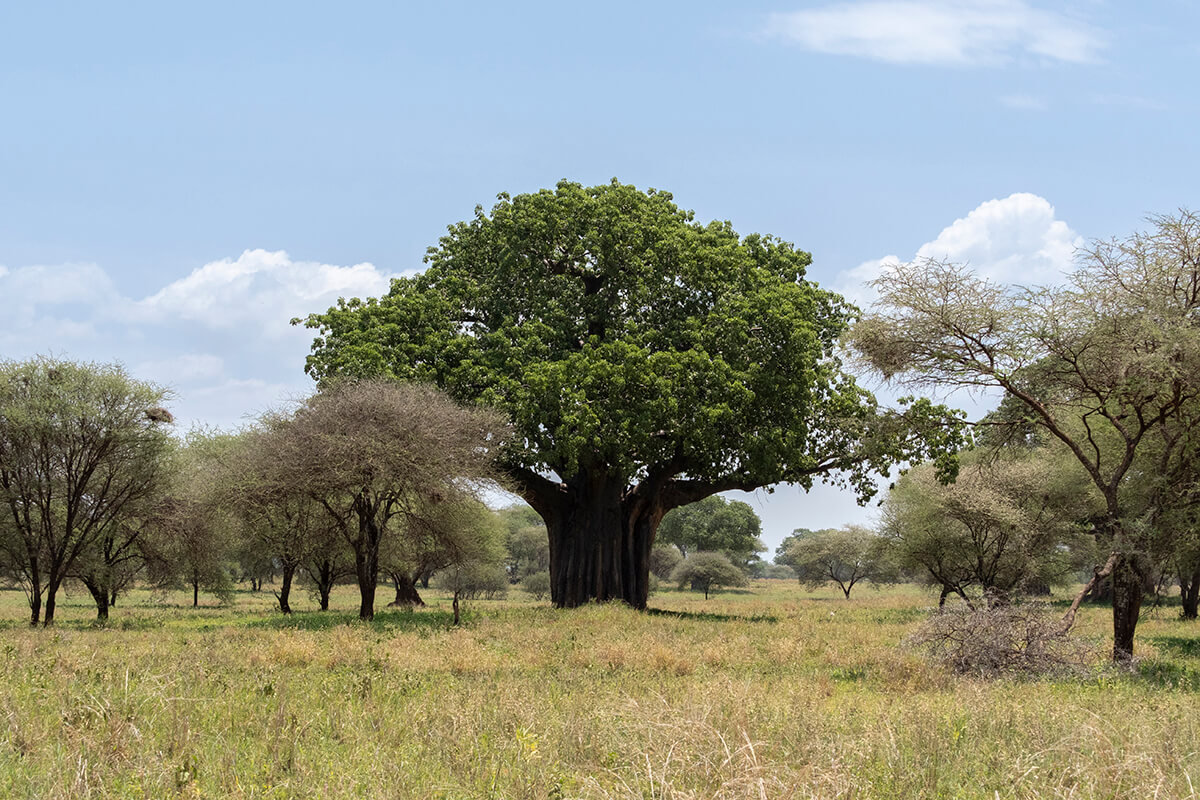
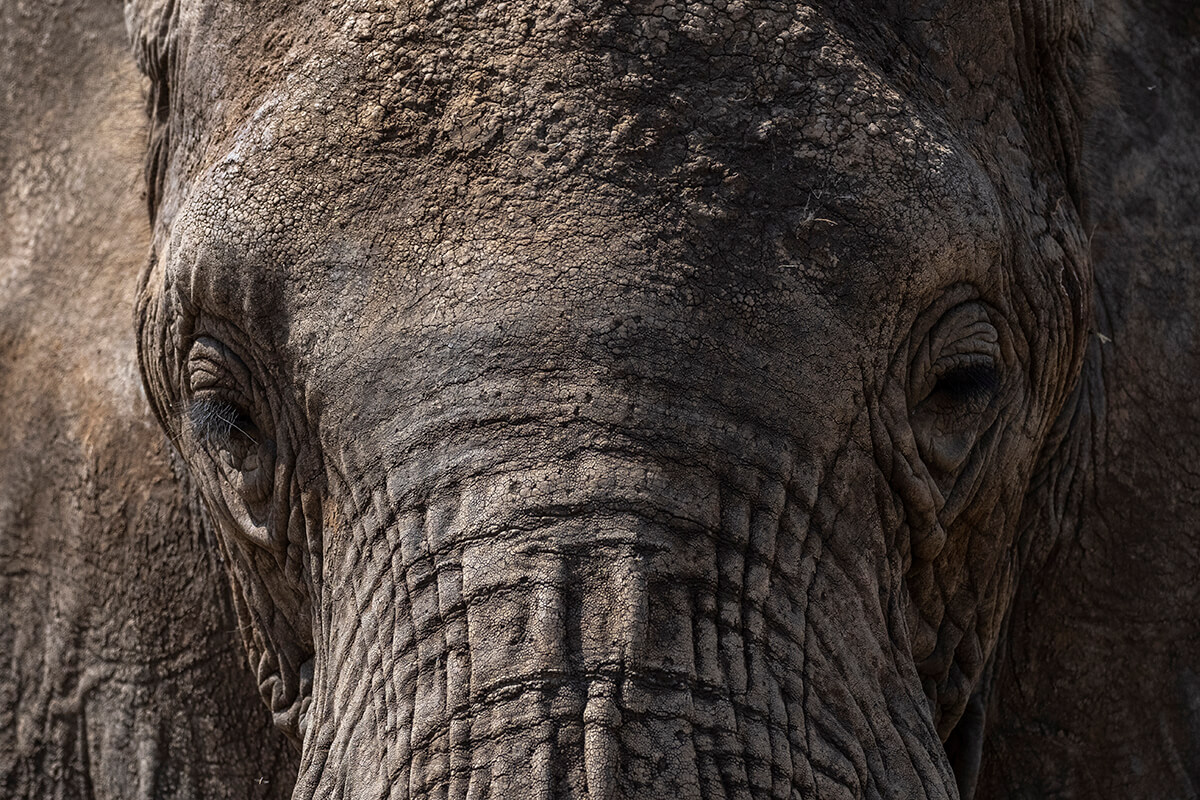
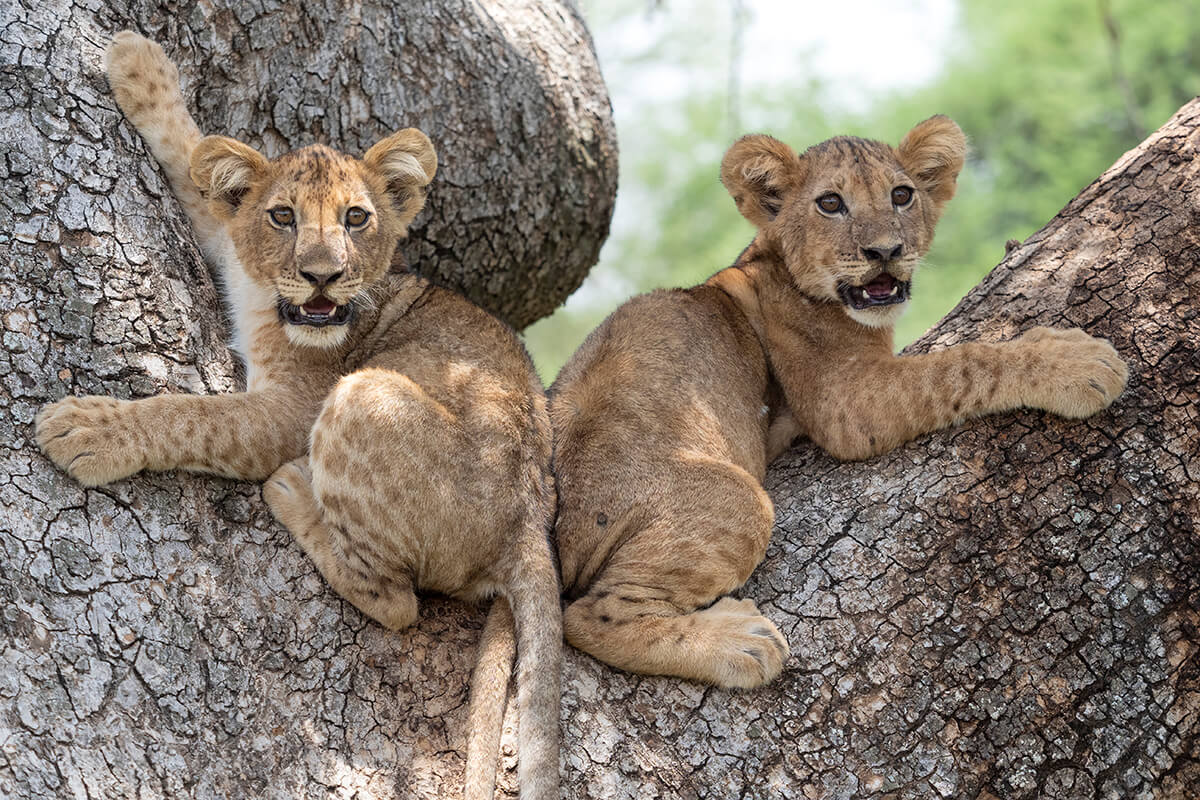
Lake Manyara National Park: My One-Day Safari Experience
Lake Manyara National Park is a small park in northern Tanzania. Two-thirds of its 300 km² area is covered by the lake. In recent years, the lake has lost its flamingos, which were once one of the park’s main attractions.
Currently, the stars of the park are its elephants and blue monkeys. The park is also famous for its tree-climbing lions, although they are quite difficult to spot.
How to get there
By road from Arusha, it takes about 1 hour and 30 minutes to reach the park. Some areas in the northern part of the park can be very crowded with tourists, especially in the afternoon.
My experience
On the last morning of my six-day safari in Tanzania, I visited this national park. The safari was rather disappointing. Besides spotting some groups of elephants and a few blue monkeys, I noticed there was very little wildlife. It was probably the least interesting safari I did while traveling in Tanzania. According to my guide, the animals move between Tarangire National Park and Manyara National Park depending on the availability of food and water. Depending on the season, they tend to concentrate mostly in one of the parks.
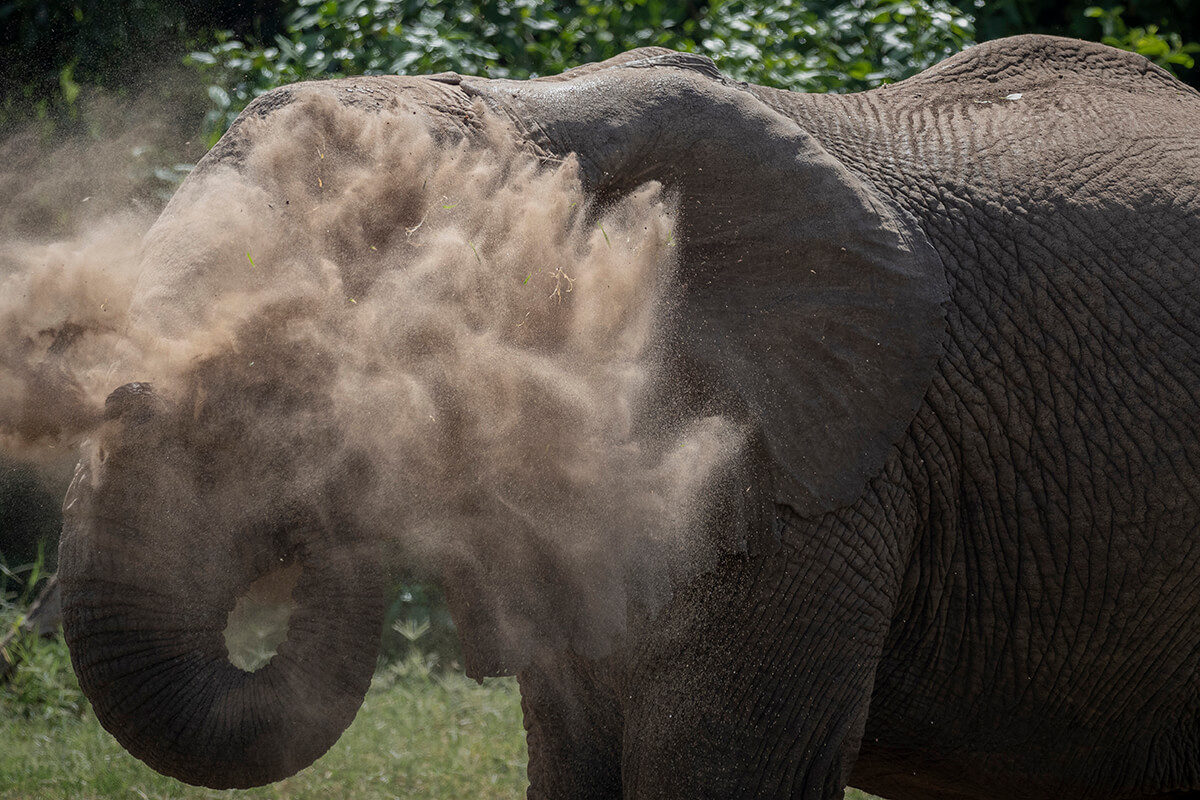
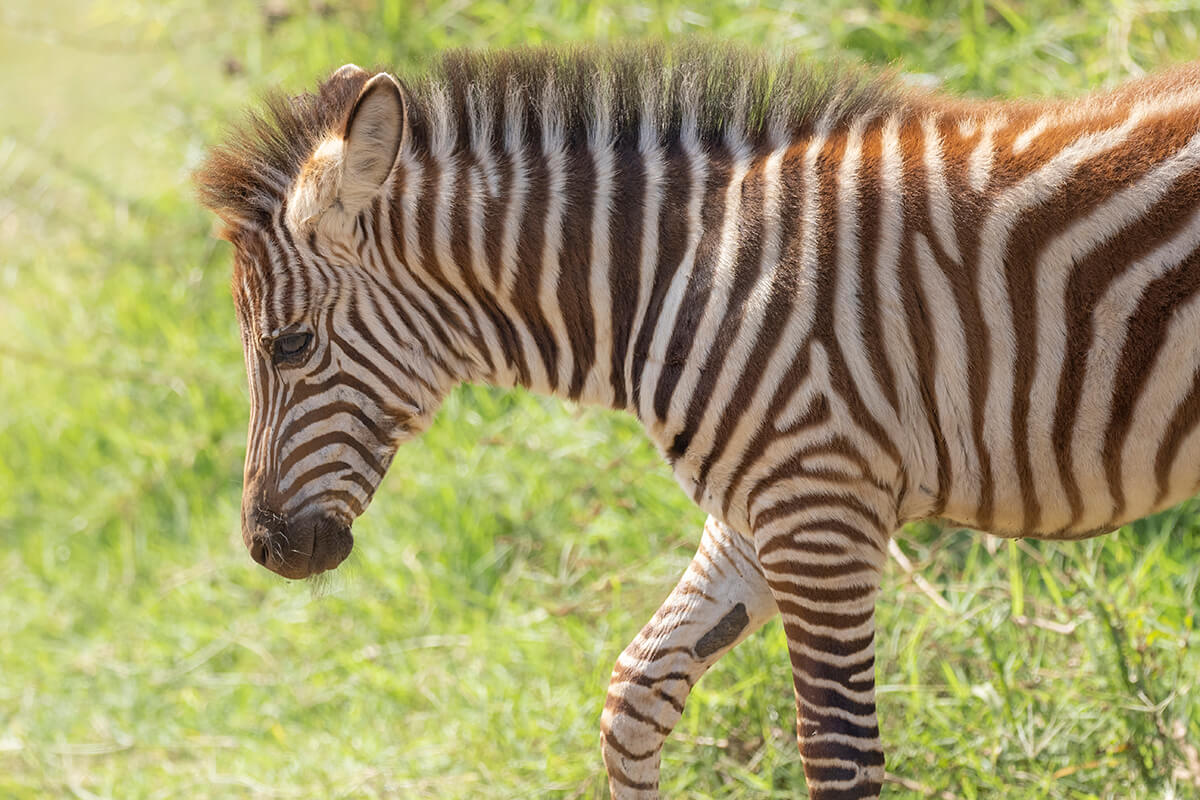
Ngorongoro Safari: Crater and Ndutu Calving Season
The Ngorongoro Conservation Area covers 8,300 km² and stretches over the eastern part of the Rift Valley, southeast of Serengeti National Park. Around 40,000 Maasai pastoralists still live there, coexisting with the abundant wildlife in the region.
Exploring this UNESCO World Heritage site means traveling through a great variety of landscapes. At the entrance, a dense forest walls the road, making it hard to spot any animals. After about 20 minutes of climbing, you reach one of the most spectacular points: the Ngorongoro Crater viewpoint. This enormous 20-kilometer-wide caldera is home to over 25,000 animals of various species that live there year-round. It is one of the best places for safaris in Tanzania throughout the year, and one of the few spots where seeing the black rhino is relatively common.
As you continue along the dusty dirt track crossing the region, the vegetation disappears, and the plains seem endless. Giraffes, zebras, wildebeests, and gazelles dominate this savanna area, along with large predators, especially lions and cheetahs.
In the southern part of the Ngorongoro Conservation Area, Lake Ndutu witnesses one of the world’s most impressive natural spectacles. From late January to early March, up to two million wildebeests gather here to give birth to the new generation. This also attracts many predators, making the area one of the most interesting for wildlife viewing.
Other attractive spots within the conservation area include Lake Eyasi and Lake Natron, from where you can see and climb Ol Doinyo Lengai—the only active volcano in Tanzania.
How to get to the Ngorongoro Conservation Area
The most common way to reach Ngorongoro by road is by booking a safari with a vehicle. Usually, safaris start from Arusha city, and it takes about three hours to reach the entrance gate, Lodoare Gate.
My experience
To get to the Serengeti, it’s common to pass through the Ngorongoro Conservation Area, so I crossed this territory several times. On each trip, one highlight was the stop at the Ngorongoro Crater viewpoint. It’s a unique landscape. With binoculars, you can spot large herds of herbivores and even see some elephants.
Driving through this conservation area, passing small Maasai villages, I mostly saw giraffes, zebras, Thomson’s gazelles, and Grant’s gazelles.
During my first safari, we headed south in search of the great migration. We found thousands of wildebeests grazing on green plains, along with a pride of lions resting peacefully. Nearby, we stopped to photograph Lake Ndutu and its flamingos. However, camping is not allowed in this area, so we could only stay a couple of hours before heading to central Serengeti.
I did two safaris in the Ngorongoro Crater. It is an exceptional area where animals are constantly visible, and lions are relatively easy to spot. On my second safari, I saw a magnificent black rhino up close.
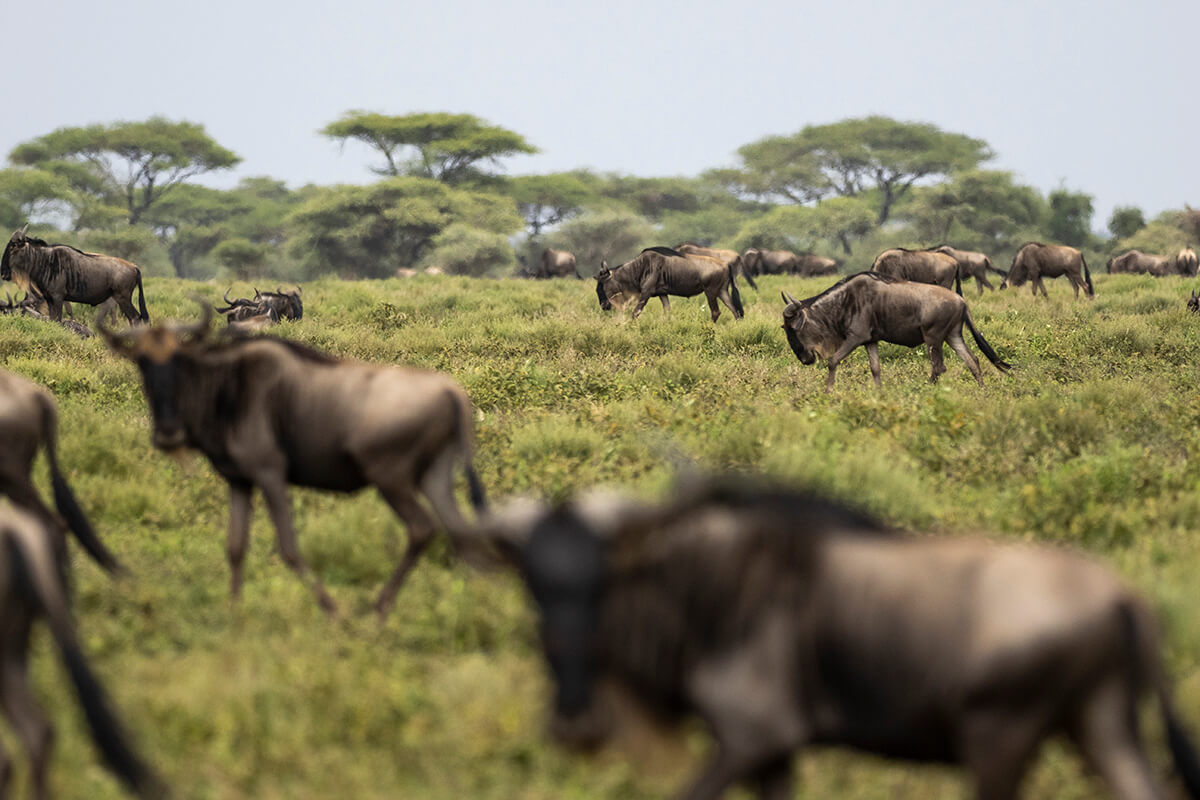

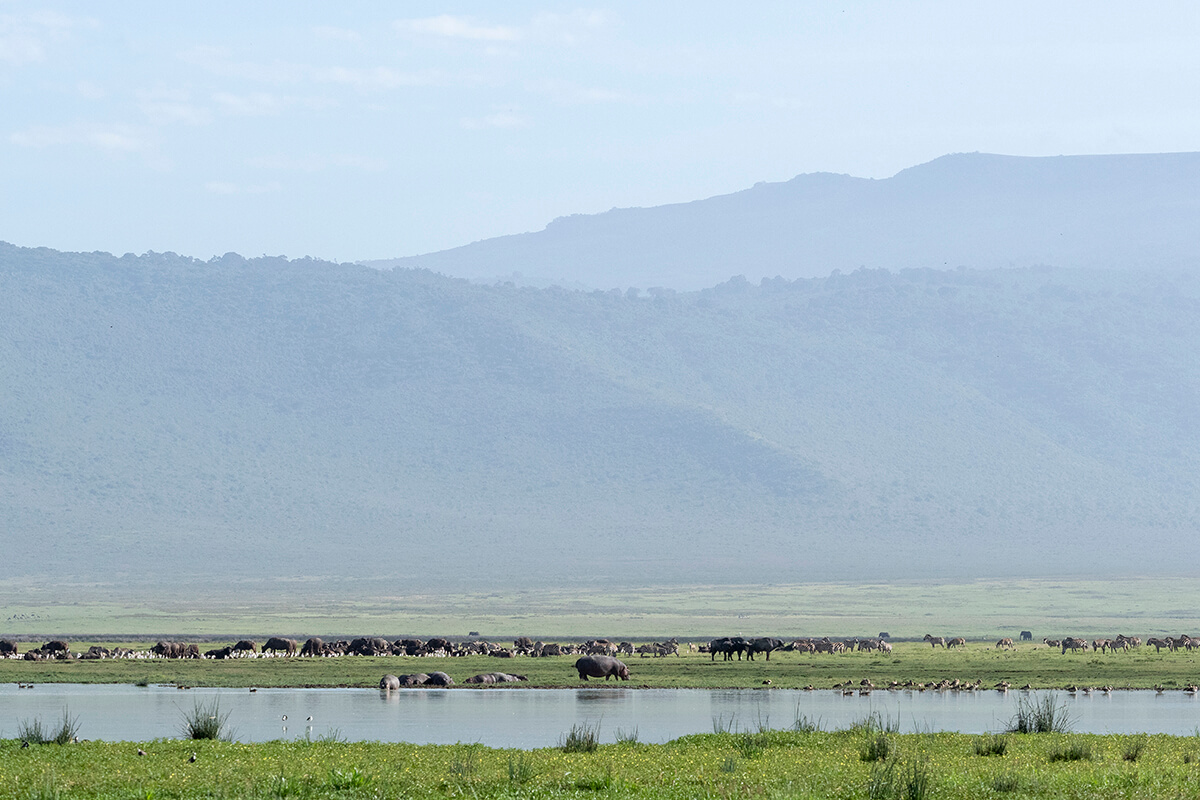
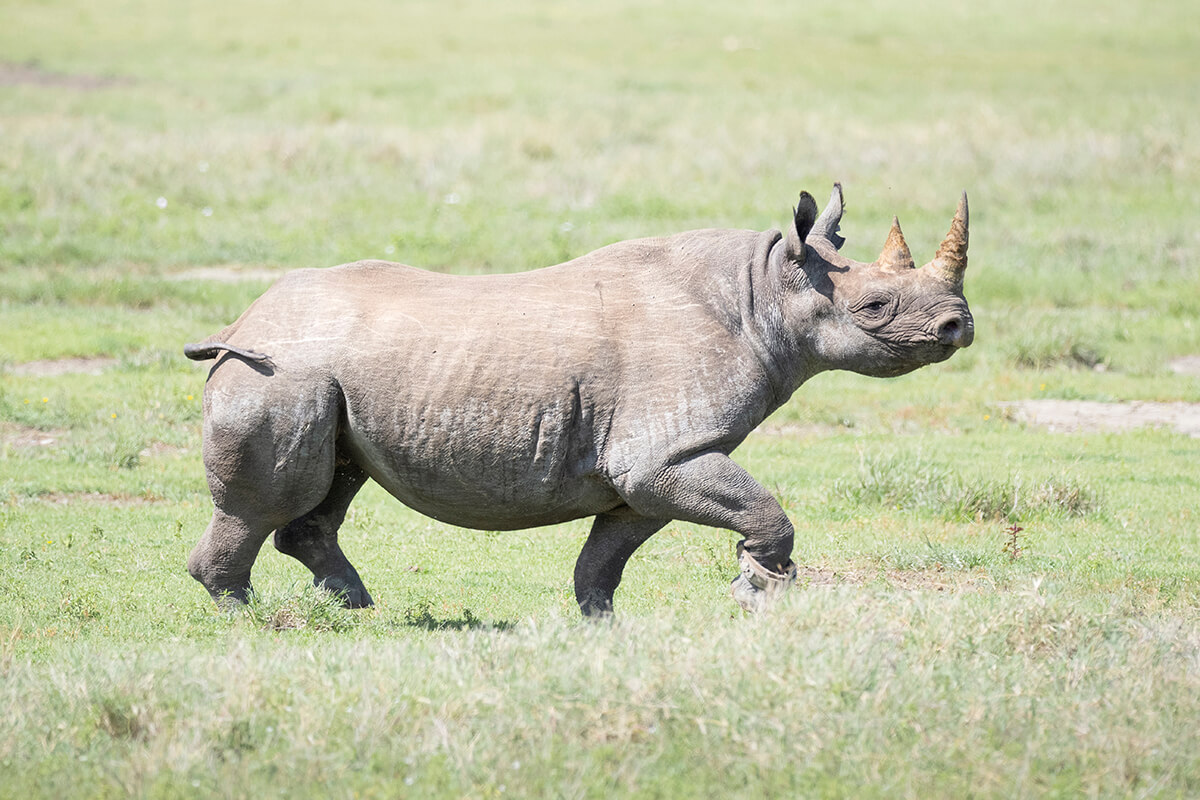
Serengeti National Park: My 3-Day Safari Experience
Serengeti National Park is one of the wildest and most impressive ecosystems you can visit in Tanzania. Serengeti means “endless plains” in the Maasai language — a perfectly fitting name. The savannah of this national park seems infinite.
The Serengeti has the largest concentration of lions in Africa; leopards are also quite abundant, especially in the Seronera area; and cheetahs are frequently seen in the southern plains.
The monotony of the savannah is only broken by some solitary acacia trees and also by some very typical rock formations in this area of Tanzania, known as kopjes. It’s easy to think of scenes from The Lion King when seeing groups of lions resting on top of these rocks.
The Serengeti is also the territory where, together with the Masai Mara, the great migration of wildebeest and other herbivores takes place. A movement of millions of animals traveling in a circular route in search of fresh green pastures. It is one of the most impressive wildlife spectacles on the planet.
Throughout Serengeti National Park, it’s also quite common to see elephants, giraffes, hippos, buffaloes, zebras, wildebeests, and hyenas. The only Big 5 species that is quite difficult to see here is the black rhinoceros.
How to get there
You can reach the Serengeti by flying from Arusha, but the more economical and common option is to go by 4×4 car. The trip takes between six and eight hours, covering about 325 kilometers. Much of this journey passes through the Ngorongoro Conservation Area, where good views and wildlife sightings are practically guaranteed.
My experience
Combining the two safaris I did during my trip to Tanzania, I ended up spending two afternoons, one full day, and two mornings in Serengeti National Park. Although it wasn’t easy to find some of the park’s most iconic animals, I was fascinated by this territory.
One morning I was lucky enough to observe and photograph a leopard while it was inspecting its territory. I also saw a pair of lions on top of a kopje, one of the scenes I was most eager to witness.
Seeing elephants was not easy, but during one morning we spent an hour surrounded by a large group of elephants. Some of them were among the biggest specimens I have ever seen.
You can also see many hippos in the Serengeti, resting in their pools (shallow, still water areas). I spent quite some time watching and photographing them.
One of the most intense moments of my stay in this national park was at the Nguchiro campsite. In the evening, while there was still light, a group of giraffes came very close to the camp. Watching them quietly while they ate under a light rain was wonderful. At night, an elephant also approached the campsite — a very exciting and somewhat unsettling visit.

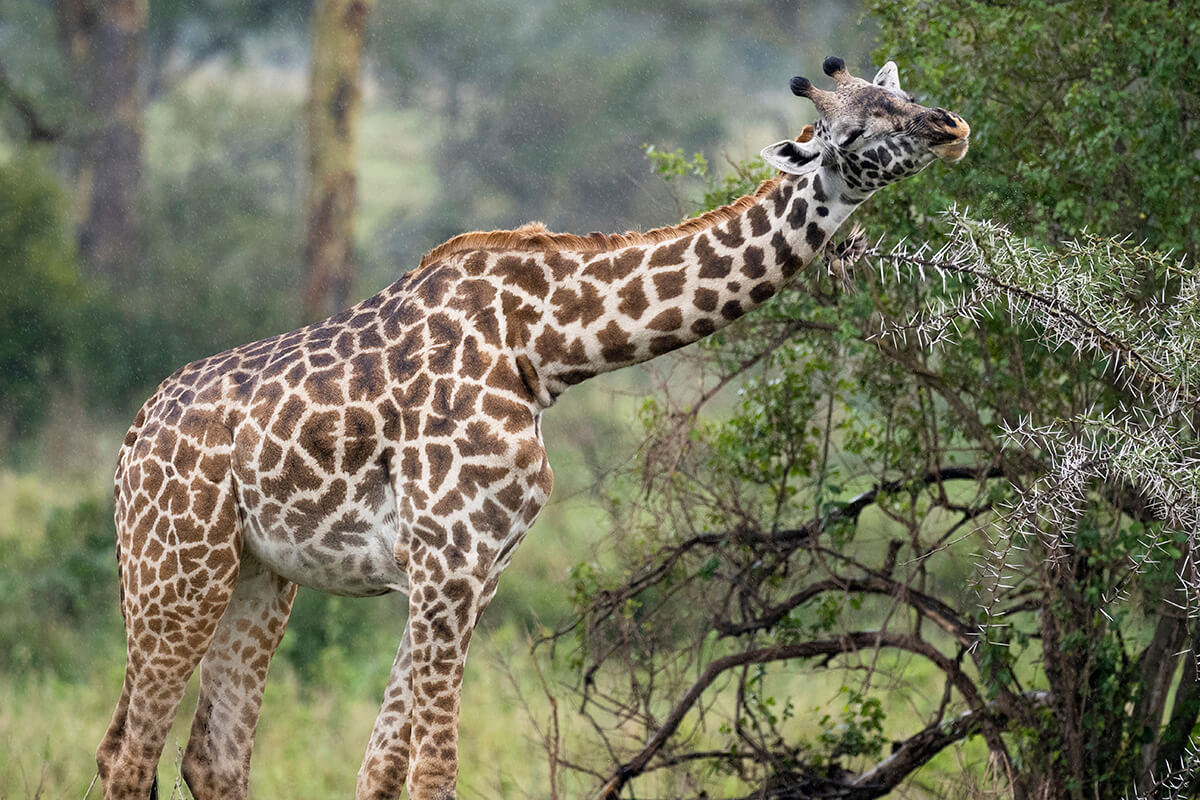

Planning a Trip to Tanzania with a Local Tour Operator
If you want to simplify your trip to Tanzania, a great option is to book a safari directly with a trusted local agency. This way, you avoid intermediaries and can access more affordable and authentic options. I’ve had the chance to book several safaris directly with local agencies in Tanzania, Kenya, Uganda and Botswana, and it has always been a very positive experience.
If you’d like to connect with recommended local agencies in Tanzania, just fill out this form, and I’ll share your details with the agency or agencies I trust, making sure they are the best fit for the type of safari you want to experience.
You can also get inspired by these itinerary suggestions I’ve created together with the local tour operators I trust in Tanzania.
9-Day Tanzania Safari: Budget Adventure Through Serengeti, Ngorongoro & More
🏕️ Mid-Range Safari💰 From $1,630 per person
View Safari10-Day Tanzania Safari: Great Migration, Culture & Acidic Lakes Safari
🏕️ Mid-Range Safari💰 From $3,200 per person
View Safari5-Day Tanzania Budget Safari – Serengeti, Ngorongoro & Tarangire Adventure
🏕️ Budget Safari💰 From $1,200 per person
View Safari6-Day Tanzania Safari for Photographers: Serengeti & Ngorongoro Crater
🏕️ Mid-Range Safari💰 From $1,750 per person
View Safari
